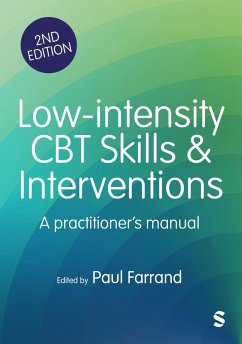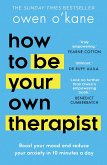Low-intensity CBT Skills and Interventions
a practitioner's manual (Second Edition (Updated Edition))
Herausgeber: Farrand, Paul A.
Low-intensity CBT Skills and Interventions
a practitioner's manual (Second Edition (Updated Edition))
Herausgeber: Farrand, Paul A.
- Broschiertes Buch
- Merkliste
- Auf die Merkliste
- Bewerten Bewerten
- Teilen
- Produkt teilen
- Produkterinnerung
- Produkterinnerung
This textbook maps onto Low-intensity CBT training programmes, supporting readers to develop the competencies and knowledge associated with practice as a Psychological Wellbeing Practitioner within NHS Talking Therapies services. It provides a manual for practice, covering assessment, decision-making and all key methods of intervention, with step-by-step guidance for each.
Andere Kunden interessierten sich auch für
![Overcoming Depression and Low Mood in Older Adults Overcoming Depression and Low Mood in Older Adults]() Chris WilliamsOvercoming Depression and Low Mood in Older Adults149,99 €
Chris WilliamsOvercoming Depression and Low Mood in Older Adults149,99 €![Overcoming Depression and Low Mood in Older Adults Overcoming Depression and Low Mood in Older Adults]() Chris WilliamsOvercoming Depression and Low Mood in Older Adults29,99 €
Chris WilliamsOvercoming Depression and Low Mood in Older Adults29,99 €![Inside the Nudge Unit Inside the Nudge Unit]() David HalpernInside the Nudge Unit11,99 €
David HalpernInside the Nudge Unit11,99 €![A Hug in a Book A Hug in a Book]() My Self-Love SupplyA Hug in a Book9,99 €
My Self-Love SupplyA Hug in a Book9,99 €![Warum Verben grün sind Warum Verben grün sind]() Susanne OttWarum Verben grün sind30,90 €
Susanne OttWarum Verben grün sind30,90 €![How to Be Your Own Therapist How to Be Your Own Therapist]() Owen Oâ KaneHow to Be Your Own Therapist8,99 €
Owen Oâ KaneHow to Be Your Own Therapist8,99 €![The Book of Shadow Work The Book of Shadow Work]() Keila ShaheenThe Book of Shadow Work21,99 €
Keila ShaheenThe Book of Shadow Work21,99 €-
-
-
This textbook maps onto Low-intensity CBT training programmes, supporting readers to develop the competencies and knowledge associated with practice as a Psychological Wellbeing Practitioner within NHS Talking Therapies services. It provides a manual for practice, covering assessment, decision-making and all key methods of intervention, with step-by-step guidance for each.
Produktdetails
- Produktdetails
- Verlag: Sage Publications Ltd
- 2 Revised edition
- Seitenzahl: 408
- Erscheinungstermin: 14. Dezember 2024
- Englisch
- Abmessung: 244mm x 170mm x 22mm
- Gewicht: 710g
- ISBN-13: 9781529680478
- ISBN-10: 1529680476
- Artikelnr.: 70942420
- Herstellerkennzeichnung
- Libri GmbH
- Europaallee 1
- 36244 Bad Hersfeld
- gpsr@libri.de
- Verlag: Sage Publications Ltd
- 2 Revised edition
- Seitenzahl: 408
- Erscheinungstermin: 14. Dezember 2024
- Englisch
- Abmessung: 244mm x 170mm x 22mm
- Gewicht: 710g
- ISBN-13: 9781529680478
- ISBN-10: 1529680476
- Artikelnr.: 70942420
- Herstellerkennzeichnung
- Libri GmbH
- Europaallee 1
- 36244 Bad Hersfeld
- gpsr@libri.de
Professor Paul Farrand is Director of the Low-Intensity Cognitive Behavioural Therapy (LICBT) clinical portfolio for the training of Psychological Wellbeing Practitioners (PWP) within Clinical Education, Development and Research (CEDAR), Psychology; University of Exeter. He has developed many of the most commonly used LICBT interventions adopted by Improving Access to Psychological Therapies (IAPT) services and is a member of the IAPT Expert Advisory Group, LICBT practitioner workforce development groups and national training and professional body accreditation committees. He is engaged in research and training associated with LICBT in several countries, currently the USA, Saudi Arabia and Sweden. In his clinical practice he has worked as Consultant Psychological Lead within the Oral and Maxillofacial Surgical hospital-based specialty for over 20 years. In recognition of his contribution to psychological therapies training, he was awarded National Teaching Fellowship in 2012.
1. Low
Intensity Cognitive Behavioural Therapy Revolution Not Evolution
Paul Farrand PART I 'Low
Intensity Clinical Method' 2. Assessment
Dona
Marie Anderson and Sarah Monk 3. Diagnoses and Problem Descriptors
Joshua E.J. Buckman, Rob Saunders and Stephen Pilling 4. Severe Mental Illness
Siobhan Gilliam and Liz Kell 5. Clinical Decision
Making
Jeffrey McDonnell, Nicola Kirkland
Davis and Rachel Newman 6. Common and Specific Factors
Zoe Symons 7. Supporting Interventions
Katie Lockwood 8. Behaviour Change Models
Paul Chadwick 9. Telephone Support
Judith Gellatly, Cintia Faija, Mia Bennion, Michael Barkham, Paul Drew and Penny Bee 10. E
mail Support
Hiba Choueiri, Michaela Newton and Paul Farrand 11. Video
Working
Eve Bampton
Wilton 12. Supervision
Faye Small and Megan Whitworth 13. Medication for Common Mental Health Problems
Rachel Miller, Alje van Hoorn, Paul Farrand and Chris Dickens PART II: Low
Intensity Interventions 14. Behavioural Activation
Paul Farrand 15. Cognitive Interventions
Simon Grist 16. Graded Exposure Therapy
Mark Papworth 17. Exposure Therapy and Response Prevention for Obsessive
Compulsive Disorder
Judith Gellatly, Rebecca Pedley, Penny Bee and Karina Lovell 18. Worry Management
Faye Small and Katie Lockwood 19. Problem
Solving
Georgina Miles 20. Sleep Management
Elaine Norton 21. CBT Groups
Chris Williams and Theresa Kelly PART III: 'Adapting Low
Intensity CBT' 22. People from Ethnic Minority Backgrounds
Palvisha Iqbal and Andrew Beck 23. Older People
Ken Laidlaw and Paul Farrand 24. Low
intensity CBT for People Living with Long
Term Conditions
Amy Blakemore, Katie Lockwood and Sarah McGahey
Intensity Cognitive Behavioural Therapy Revolution Not Evolution
Paul Farrand PART I 'Low
Intensity Clinical Method' 2. Assessment
Dona
Marie Anderson and Sarah Monk 3. Diagnoses and Problem Descriptors
Joshua E.J. Buckman, Rob Saunders and Stephen Pilling 4. Severe Mental Illness
Siobhan Gilliam and Liz Kell 5. Clinical Decision
Making
Jeffrey McDonnell, Nicola Kirkland
Davis and Rachel Newman 6. Common and Specific Factors
Zoe Symons 7. Supporting Interventions
Katie Lockwood 8. Behaviour Change Models
Paul Chadwick 9. Telephone Support
Judith Gellatly, Cintia Faija, Mia Bennion, Michael Barkham, Paul Drew and Penny Bee 10. E
mail Support
Hiba Choueiri, Michaela Newton and Paul Farrand 11. Video
Working
Eve Bampton
Wilton 12. Supervision
Faye Small and Megan Whitworth 13. Medication for Common Mental Health Problems
Rachel Miller, Alje van Hoorn, Paul Farrand and Chris Dickens PART II: Low
Intensity Interventions 14. Behavioural Activation
Paul Farrand 15. Cognitive Interventions
Simon Grist 16. Graded Exposure Therapy
Mark Papworth 17. Exposure Therapy and Response Prevention for Obsessive
Compulsive Disorder
Judith Gellatly, Rebecca Pedley, Penny Bee and Karina Lovell 18. Worry Management
Faye Small and Katie Lockwood 19. Problem
Solving
Georgina Miles 20. Sleep Management
Elaine Norton 21. CBT Groups
Chris Williams and Theresa Kelly PART III: 'Adapting Low
Intensity CBT' 22. People from Ethnic Minority Backgrounds
Palvisha Iqbal and Andrew Beck 23. Older People
Ken Laidlaw and Paul Farrand 24. Low
intensity CBT for People Living with Long
Term Conditions
Amy Blakemore, Katie Lockwood and Sarah McGahey
1. Low
Intensity Cognitive Behavioural Therapy Revolution Not Evolution
Paul Farrand PART I 'Low
Intensity Clinical Method' 2. Assessment
Dona
Marie Anderson and Sarah Monk 3. Diagnoses and Problem Descriptors
Joshua E.J. Buckman, Rob Saunders and Stephen Pilling 4. Severe Mental Illness
Siobhan Gilliam and Liz Kell 5. Clinical Decision
Making
Jeffrey McDonnell, Nicola Kirkland
Davis and Rachel Newman 6. Common and Specific Factors
Zoe Symons 7. Supporting Interventions
Katie Lockwood 8. Behaviour Change Models
Paul Chadwick 9. Telephone Support
Judith Gellatly, Cintia Faija, Mia Bennion, Michael Barkham, Paul Drew and Penny Bee 10. E
mail Support
Hiba Choueiri, Michaela Newton and Paul Farrand 11. Video
Working
Eve Bampton
Wilton 12. Supervision
Faye Small and Megan Whitworth 13. Medication for Common Mental Health Problems
Rachel Miller, Alje van Hoorn, Paul Farrand and Chris Dickens PART II: Low
Intensity Interventions 14. Behavioural Activation
Paul Farrand 15. Cognitive Interventions
Simon Grist 16. Graded Exposure Therapy
Mark Papworth 17. Exposure Therapy and Response Prevention for Obsessive
Compulsive Disorder
Judith Gellatly, Rebecca Pedley, Penny Bee and Karina Lovell 18. Worry Management
Faye Small and Katie Lockwood 19. Problem
Solving
Georgina Miles 20. Sleep Management
Elaine Norton 21. CBT Groups
Chris Williams and Theresa Kelly PART III: 'Adapting Low
Intensity CBT' 22. People from Ethnic Minority Backgrounds
Palvisha Iqbal and Andrew Beck 23. Older People
Ken Laidlaw and Paul Farrand 24. Low
intensity CBT for People Living with Long
Term Conditions
Amy Blakemore, Katie Lockwood and Sarah McGahey
Intensity Cognitive Behavioural Therapy Revolution Not Evolution
Paul Farrand PART I 'Low
Intensity Clinical Method' 2. Assessment
Dona
Marie Anderson and Sarah Monk 3. Diagnoses and Problem Descriptors
Joshua E.J. Buckman, Rob Saunders and Stephen Pilling 4. Severe Mental Illness
Siobhan Gilliam and Liz Kell 5. Clinical Decision
Making
Jeffrey McDonnell, Nicola Kirkland
Davis and Rachel Newman 6. Common and Specific Factors
Zoe Symons 7. Supporting Interventions
Katie Lockwood 8. Behaviour Change Models
Paul Chadwick 9. Telephone Support
Judith Gellatly, Cintia Faija, Mia Bennion, Michael Barkham, Paul Drew and Penny Bee 10. E
mail Support
Hiba Choueiri, Michaela Newton and Paul Farrand 11. Video
Working
Eve Bampton
Wilton 12. Supervision
Faye Small and Megan Whitworth 13. Medication for Common Mental Health Problems
Rachel Miller, Alje van Hoorn, Paul Farrand and Chris Dickens PART II: Low
Intensity Interventions 14. Behavioural Activation
Paul Farrand 15. Cognitive Interventions
Simon Grist 16. Graded Exposure Therapy
Mark Papworth 17. Exposure Therapy and Response Prevention for Obsessive
Compulsive Disorder
Judith Gellatly, Rebecca Pedley, Penny Bee and Karina Lovell 18. Worry Management
Faye Small and Katie Lockwood 19. Problem
Solving
Georgina Miles 20. Sleep Management
Elaine Norton 21. CBT Groups
Chris Williams and Theresa Kelly PART III: 'Adapting Low
Intensity CBT' 22. People from Ethnic Minority Backgrounds
Palvisha Iqbal and Andrew Beck 23. Older People
Ken Laidlaw and Paul Farrand 24. Low
intensity CBT for People Living with Long
Term Conditions
Amy Blakemore, Katie Lockwood and Sarah McGahey









